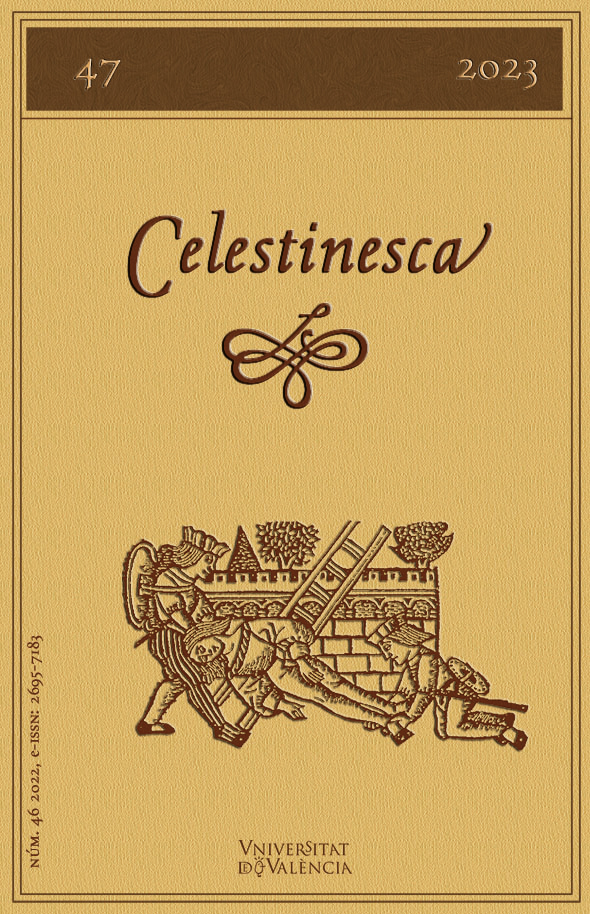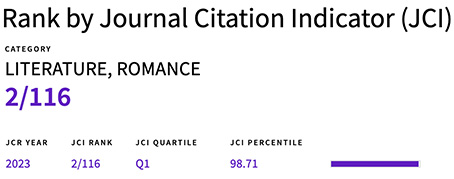Celestina painted by Picasso: birth of a modern myth
DOI:
https://doi.org/10.7203/Celestinesca.47.26875Keywords:
Roland Barthes, Celestina, collective identity, modern myth, Pablo Picasso Abstract
Abstract
The Renaissance character of Celestina experienced, from the 19th century, a new boom. Not only did she reappear in several literary texts, but she also became a frequent motif of pictorial art. The Spanish painter Pablo Picasso had a particular taste for Celestina. Throughout his whole work he repeatedly represented the procuress, contributing to her elevation to a modern myth, that is, according to Roland Barthes, an object which conveys a message complementary to its actual meaning. In the case of Celestina, this message refers to a collective identity diametrically opposed to what is considered good taste. The drawing Celestina Knitting resorts to the metaphorical inventory of folklore to permit the reception of the myth by a broad public. The portrait Celestina, whose model was the owner of a Barcelonian brothel, insists on the referential function of the procuress, thanks to whom the myth can perpetuate in the painter’s present. With the engravings from the Suite 347, Picasso renews the editorial practices of the Renaissance, engaging a dialogue between his paintings and its textual sources. This way he can emphasize the visual essence of the Celestinesque myth.
 Downloads
Downloads
 References
References
Baker, Susan (2009), "A Duel with Fernando de Rojas: Picasso’s Celestina Prints", Janus Head, 2/1-2, pp. 219-238. http://janushead.org/2009/10 [accedido el 10/11/2023]
Barthes, Roland (1957), Mythologies, París, Seuil.
Beltrán, Luis (1996), "The Author’s Author, Typography, and Sex: The Fourteenth Mamotreto of La Lozana andaluza", en The Picaresque. Tradition and Displacement, ed. Giancarlo Maiorino, Mineápolis, University of Minessota Press, pp. 86-136.
Botta, Patrizia (1994), "La magia en La Celestina", Dicenda, 12, pp. 37-67. https://revistas.ucm.es/index.php/DICE/article/view/DICE9494110037A [accedido el 10/11/2023]
Covarrubias Horozco, Sebastián de (2006), Tesoro de la lengua castellana o española, ed. Ignacio Arellano y Rafael Zafra, Madrid – Fráncfort, Iberoamericana – Vervuert.
Delicado, Francisco (2007), La Lozana andaluza, ed. Jacques Joset y Folke Gernert, Barcelona, Galaxia Gutenberg – Círculo de Lectores.
Deyermond, Alan (1977), "Hilado-cordón-cadena: Symbolic Equivalence in La Celestina", Celestinesca, 1, pp. 6-12. https://doi.org/10.7203/Celestinesca.1.19447
Fernández, Enrique, "The Images of Celestina and Its Visual Culture", en A Companion to Celestina, ed. Enrique Fernández, Leiden, Brill, pp. 362-382. https://doi.org/10.1163/9789004349322_023
Fontes, Manuel da Costa (1984), "Celestina’s hilado and Related Symbols", Celestinesca, 8/1, pp. 3-13. https://doi.org/10.7203/Celestinesca.8.19582
Fontes, Manuel da Costa (1991), "Celestina as an Antithesis of the Virgin Mary", Journal of Hispanic Philology, 15, pp. 7-41.
Fontes, Manuel da Costa (2017), "Jesus and Mary, Christian Prayer, and the Saints in Celestina", en A Companion to Celestina, ed. Enrique Fernández, Leiden, Brill, pp. 242-261. https://doi.org/10.1163/9789004349322_016
François, Jéromine (2020), "La Celestina", un mito literario contemporáneo, Madrid – Fráncfort, Iberoamericana – Vervuert.
Greenblatt, Stephen (1988), Shakespearean Negotiations. The Circulation of Social Energy in Renaissance England, Oxford, Clarendon Press.
Griffin, Clive (2001), "Celestina’s Illustrations", Bulletin of Hispanic Studies, 78/1, pp. 59-79. https://doi.org/10.1080/000749001750058536
Herrera, Javier (1995), Picasso, Madrid y el 98: la revista «Arte Joven», Madrid, Cátedra.
Juberías Gracia, Guillermo (2023), "Alcahuetas, ventaneras y majas del paseo: imágenes de celestinas en la pintura de género española (1868-1931)", Celestinesca, 47, pp. por confirmar. https://doi.org/10.7203/Celestinesca.47.26741
Kehren, Timo (2020), Königreich Sodom: Politik der Lust in der spanischen Pikareske, Göttingen, Vandenhoeck & Ruprecht.
Maeztu, Ramiro de (2004), Don Quijote, Don Juan y La Celestina: ensayos en simpatía, prólogo de José-Carlos Mainer, Madrid, Visor Libros.
Montero, Ana Isabel (2015), "Reading at the Threshold: The Role of Illustrations in the Reception of the Early Editions of Celestina", Celestinesca, 39, pp. 197-224. https://doi.org/10.7203/Celestinesca.39.20185
Redondo, Augustin (1987), "Folklore y literatura en el Lazarillo de Tormes: un planteamiento nuevo (El 'caso' de los tres primeros tratados)", en Mitos, folklore y literatura, ed. Aurora Egido, Zaragoza, Caja de Ahorros y Monte de Piedad, pp. 79-110.
Rico, Francisco (1990), "Las primeras Celestinas de Picasso", Bulletin hispanique, 92/1, pp. 609-626. https://doi.org/10.3406/hispa.1990.4713
Rojas, Fernando de (1971), La Célestine, París, Éditions de l’Atelier Crommelynck.
Rojas, Fernando de (1991), Comedia o Tragicomedia de Calisto y Melibea, ed. Peter E. Russell, Madrid, Castalia.
Ruggerio, Michael, J. (1966), The Evolution of the Go-Between in Spanish Literature Through the Sixteenth Century, Berkeley, University of California Press.
Salus, Carol (2015), Picasso and Celestina. The Artist’s Vision of the Procuress, Newark, Juan de la Cuesta.
Schmidt, Rachel (2015), "Celestinas y majas en la obra de Goya, Alenza y Lucas Velázquez", Celestinesca, 39, pp. 275-328. https://doi.org/10.7203/Celestinesca.39.20188
Downloads
Published
How to Cite
-
Abstract298
-
PDF (Español)277
Issue
Section
License
![]() Celestinesca is committed to the dissemination of knowledge, that is why access to its contents is free and is ruled by a Creative Commons Attribution-NonCommercial-NoDerivatives 4.0 license.
Celestinesca is committed to the dissemination of knowledge, that is why access to its contents is free and is ruled by a Creative Commons Attribution-NonCommercial-NoDerivatives 4.0 license.
Authors retain the rights to their works. Therefore, they can disseminate them and deposit them in the repository, institutional or not, that they wish. However, they are kindly requested to do so by providing the full bibliographic reference and the corresponding DOI.
Celestinesca does not charge authors for submitting, processing, reviewing or publishing their articles.





